Paali is a member of the Indo-European
family of languages, together with most languages of Europe, Iran and northern
India. Inside this family it belongs to so-called Middle Indo-Aryan languages.
This group is also called Prakrits in Indian linguistic works. Paali can be
considered as one of the oldest surviving Prakrits.
The origin of Paali is still unclear. It was for a long
time considered to be identical with Maagadhii, the Prakrit of Magadha, where
the Buddha spent most of his life and teaching career. This ancient region
is situated in modern Indian state of Bihar, in North-Eastern India. But more
careful examination in recent years showed that Paali bears closer resemblance
to Prakrits of Western India than to that of Magadha. The famous Indian emperor
and patron of Buddhism A`soka, who lived only a few centuries after the Buddha,
left many inscriptions all over his empire which stretched far beyond the
borders of present day India. All these inscriptions were written in local
vernaculars, using different scripts that were in use in that place and time.
Paali is very close in grammar and orthography to the language of the inscriptions
in what is now the Indian state of Uttarpradesh.
Therefore it is safe to assume that Paali was created artificially,
probably not on purpose, but rather as monks and nuns from different parts
of India came into contact with each other and were forced to adapt their
vernaculars to new environments in order to understand and be understood.
Paali was and is written in many different scripts. In India,
it was written in ancient Indian scripts Braahmii and Kharo.s.thii. When Buddhism
spread to other parts of the world, local people used either original Indian
scripts (so Kharo.s.thii was used for a long time in Central Asia) or switched
to their own local scripts. So in Sri Lanka, Paali is written in Sinhalese
script, in Burma it is Burmese script, in Thailand Thai script and in Cambodia
the Khmer script. Finally, when Western scholars and practitioners started
to learn about Buddhism, they used Roman characters to write Paali language.
This page was created using some material downloaded from
Omniglot
Miroslav Rozehnal
November 2001
back to index
Brahmi Script (India)

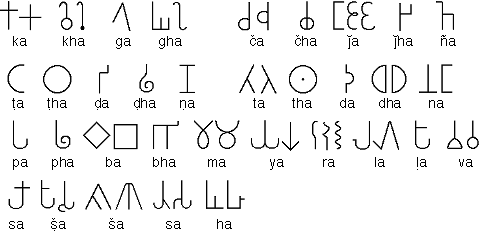

back to index
Kharosthi Script (India)

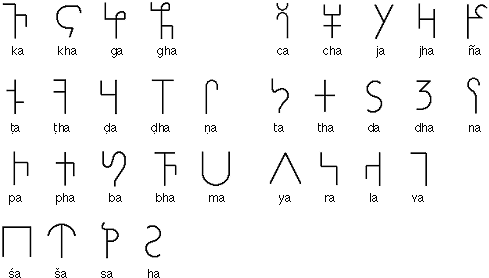
back to index
Devanagari Script (India)

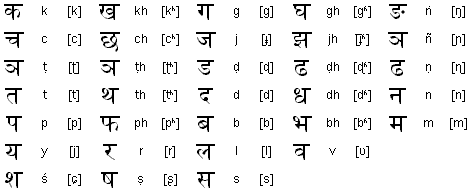



back to index
Sinhalese (Sri Lanka) Script

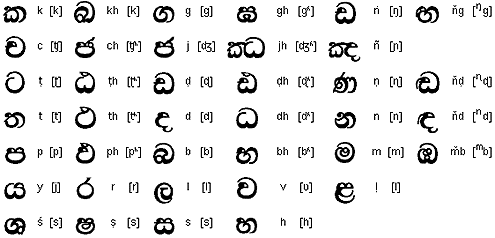

back to index
Burmese Script (Burma/Myanmar)
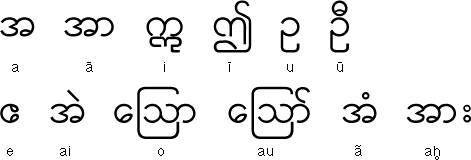
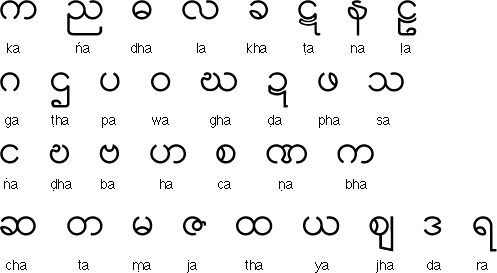

back to index
Thai Script (Thailand)
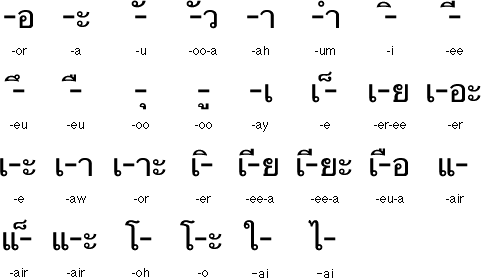
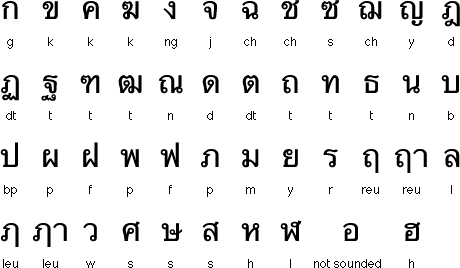

back to index
Lao Script (Laos)

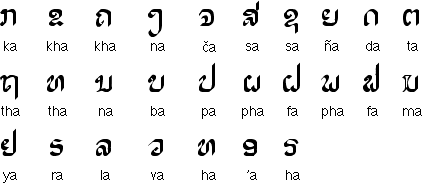


back to index
Khmer Script (Cambodia)

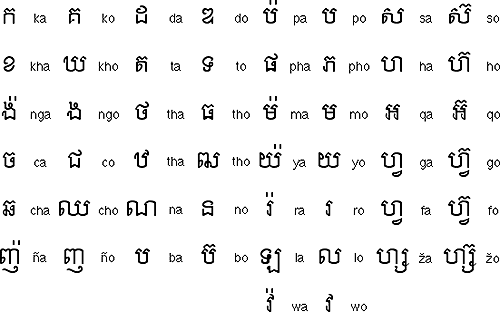

back to index
Romanized Alphabets and Pronunciation
back to index
Alphabets in Dictionary Order
| Vowels |
Vowels |
a |
a |
i |
i |
u |
u |
| Diphthongs |
e |
o |
|
|
|
|
| Consonants |
Nasals |
j |
|
|
|
|
|
| Gutturals |
k |
kh |
g |
gh |
v |
|
| Palatals |
c |
ch |
j |
jh |
b |
|
| Cerebrals |
t |
th |
d |
dh |
n |
|
| Dentals |
t |
th |
d |
dh |
n |
|
| Labials |
p |
ph |
b |
bh |
m |
|
| Semivowels |
y |
r |
l |
l |
lh |
v |
| Sibilants |
s |
|
|
|
|
|
| Aspirate |
h |
|
|
|
|
|
back to index
Pronunciation Practice
Pronunciation of Words
(The English translation of these words is by no means exhaustive)
Assaji Assaji (a personal name)
arahant Arahant, Arhat
anicca impermanent
atha then
attan Self
ayasmant Venerable (a title of respect for senior monks)
aha said
buddho Buddha
bhagavant Blessed One (a title used for the uddha)
cittaj mind
ca and
Pronunciation of Sentences
1) Namaskara
Namo tassa bhagavato arahato sammasajbuddhassa (Homage to Him, Blessed One, Arahant, truly and completely Awakened One.)
2) Tisarana
buddhaj saranaj gacchami (I take refuge in the Buddha.)
dhammaj saranaj gacchami (I take refuge in the Teaching.)
savghaj saranaj gacchami (I take refuge in the Community.)
3) Dhammapada 354
sabbadanaj dhammadanaj jinati (The gift of Dharma conquers all gifts.)
sabbarasaj dhammaraso jinati (The taste of Dharma excels all tastes.)
sabbaratij dhammarati jinati (The joy of Dharma excels all joys.)
tanhakkhayo sabbadukkhaj jinati (The destruction of thirst conquers all suffering.)
4) Dhammapada 183
sabbapapassa akaranaj (Not doing the evil deeds,)
kusalassa upasampada (Gathering the wholesome,)
sacittapariyodapanaj (Purifying one's own mind -)
etaj buddhana sasanaj (That is teaching of the buddhas.)
5) Vinaya-pitaka, Mahavagga, I. 40. (5)
atha kho ayasma Assaji And then Venerable Assaji
Sariputtassa paribbajakassa to the wandering mendicant Sariputta
imaj dhammapariyayaj abhasi: spoke this Dhamma-exposition:
ye dhamma hetuppabhava Whatever phenomena arise from cause,
tesaj hetuj tathagato aha their cause the Tathagata proclaimed.
tesab ca yo nirodho And what is their cessation.
evajvadi mahasamano This is the teaching of the Great Contemplative.
6) Three characteristics of Existence (tini lakkhanani)
(a) Aniccalakkhana (Dhammapada 277)
sabbe savkhara anicca ti ("All conditioned things are impermanent,")
yada pabbaya passati (when one perceives with wisdom,)
atha nibbindati dukkhe (then one turns away from suffering.)
esa maggo visuddhiya (This is the path of purification.)
(b) Dukkhalakkhana (Dhammapada 278)
sabbe savkhara dukkha ti ("All conditioned things are unsatisfactory,")
yada pabbaya passati (when one perceives with wisdom,)
atha nibbindati dukkhe (then one turns away from suffering.)
esa maggo visuddhiya (This is the path of purification.)
(c) Anattalakkhana (Dhammapada 279)
sabbe dhamma anatta ti ("All things are without a Self,")
yada pabbaya passati (when one perceives with wisdom,)
atha nibbindati dukkhe (then one turns away from suffering.)
esa maggo visuddhiya (This is the path of purification.)
7) Mahaparinibbanasuttanta
Parinibbute Bhagavati saha parinibbana When the Blessed One had passed away, simultaneously with his Parinibbana,
Sakko devanam indo Sakka, king of the gods,
imaj gathaj abhasi: spoke this stanza:
'Anicca vata savkhara, "Transient are all compounded things,
uppada-vaya-dhammino; Subject to arise and vanish;
Uppajjitva nirujjhanti, Having come into existence they pass way;
tesaj vupasamo sukho' ti. Good is the peace when they forever cease."
back to index 






















